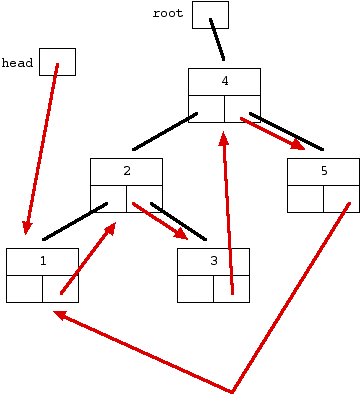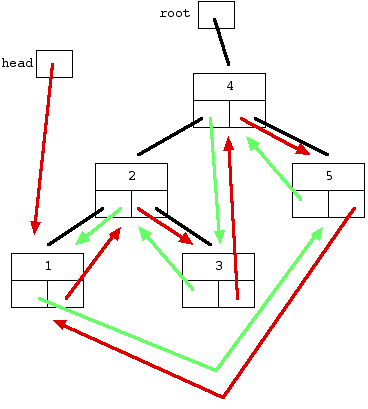
Figure-1 -- ordered binary tree
This article presents one of the neatest recursive pointer problems ever devised. This an advanced problem that uses pointers, binary trees, linked lists, and some significant recursion. This article includes the problem statement, a few explanatory diagrams, and sample solution code in Java and C. Thanks to Stuart Reges for originally showing me the problem.

Figure-1 -- ordered binary tree
All the nodes in the "small" sub-tree are less than or equal to the data in the parent node. All the nodes in the "large" sub-tree are greater than the parent node. So in the example above, all the nodes in the "small" sub-tree off the 4 node are less than or equal to 4, and all the nodes in "large" sub-tree are greater than 4. That pattern applies for each node in the tree. A null pointer effectively marks the end of a branch in the tree. Formally, a null pointer represents a tree with zero elements. The pointer to the topmost node in a tree is called the "root".

The circular doubly linked list is a standard linked list with two additional features...

The single node in a length-1 list is both the first and last node, so its pointers point to itself. Fortunately, the length-1 case obeys the rules above so no special case is required.

Figure-4 -- original tree with list "next" arrows added
This drawing shows the original tree drawn with plain black lines with
the "next" pointers for the desired list structure drawn as arrows. The
"previous" pointers are not shown.

Figure-5 -- original tree with "next" and "previous" list arrows added
Try the problem directly, or see the hints below.
// TreeList.java
/*
Demonstrates the greatest recursive pointer problem ever --
recursively changing an ordered binary tree into a circular
doubly linked list.
See http://cslibrary.stanford.edu/109/
This code is not especially OOP.
This code is free for any purpose.
Feb 22, 2000
Nick Parlante nick.parlante@cs.stanford.edu
*/
/*
This is the simple Node class from which the tree and list
are built. This does not have any methods -- it's just used
as dumb storage by TreeList.
The code below tries to be clear where it treats a Node pointer
as a tree vs. where it is treated as a list.
*/
class Node {
int data;
Node small;
Node large;
public Node(int data) {
this.data = data;
small = null;
large = null;
}
}
/*
TreeList main methods:
-join() -- utility to connect two list nodes
-append() -- utility to append two lists
-treeToList() -- the core recursive function
-treeInsert() -- used to build the tree
*/
class TreeList {
/*
helper function -- given two list nodes, join them
together so the second immediately follow the first.
Sets the .next of the first and the .previous of the second.
*/
public static void join(Node a, Node b) {
a.large = b;
b.small = a;
}
/*
helper function -- given two circular doubly linked
lists, append them and return the new list.
*/
public static Node append(Node a, Node b) {
// if either is null, return the other
if (a==null) return(b);
if (b==null) return(a);
// find the last node in each using the .previous pointer
Node aLast = a.small;
Node bLast = b.small;
// join the two together to make it connected and circular
join(aLast, b);
join(bLast, a);
return(a);
}
/*
--Recursion--
Given an ordered binary tree, recursively change it into
a circular doubly linked list which is returned.
*/
public static Node treeToList(Node root) {
// base case: empty tree -> empty list
if (root==null) return(null);
// Recursively do the subtrees (leap of faith!)
Node aList = treeToList(root.small);
Node bList = treeToList(root.large);
// Make the single root node into a list length-1
// in preparation for the appending
root.small = root;
root.large = root;
// At this point we have three lists, and it's
// just a matter of appending them together
// in the right order (aList, root, bList)
aList = append(aList, root);
aList = append(aList, bList);
return(aList);
}
/*
Given a non-empty tree, insert a new node in the proper
place. The tree must be non-empty because Java's lack
of reference variables makes that case and this
method messier than they should be.
*/
public static void treeInsert(Node root, int newData) {
if (newData<=root.data) {
if (root.small!=null) treeInsert(root.small, newData);
else root.small = new Node(newData);
}
else {
if (root.large!=null) treeInsert(root.large, newData);
else root.large = new Node(newData);
}
}
// Do an inorder traversal to print a tree
// Does not print the ending "\n"
public static void printTree(Node root) {
if (root==null) return;
printTree(root.small);
System.out.print(Integer.toString(root.data) + " ");
printTree(root.large);
}
// Do a traversal of the list and print it out
public static void printList(Node head) {
Node current = head;
while (current != null) {
System.out.print(Integer.toString(current.data) + " ");
current = current.large;
if (current == head) break;
}
System.out.println();
}
// Demonstrate tree->list with the list 1..5
public static void main(String[] args) {
// first build the tree shown in the problem document
// http://cslibrary.stanford.edu/109/
Node root = new Node(4);
treeInsert(root, 2);
treeInsert(root, 1);
treeInsert(root, 3);
treeInsert(root, 5);
System.out.println("tree:");
printTree(root); // 1 2 3 4 5
System.out.println();
System.out.println("list:");
Node head = treeToList(root);
printList(head); // 1 2 3 4 5 yay!
}
}
/*
TreeList.c
C code version of the great Tree-List recursion problem.
See http://cslibrary.stanford.edu/109/ for the full
discussion and the Java solution.
This code is free for any purpose.
Feb 22, 2000
Nick Parlante nick.parlante@cs.stanford.edu
*/
#include <stdio.h>
#include <stddef.h>
#include <stdlib.h>
/* The node type from which both the tree and list are built */
struct node {
int data;
struct node* small;
struct node* large;
};
typedef struct node* Node;
/*
helper function -- given two list nodes, join them
together so the second immediately follow the first.
Sets the .next of the first and the .previous of the second.
*/
static void join(Node a, Node b) {
a->large = b;
b->small = a;
}
/*
helper function -- given two circular doubly linked
lists, append them and return the new list.
*/
static Node append(Node a, Node b) {
Node aLast, bLast;
if (a==NULL) return(b);
if (b==NULL) return(a);
aLast = a->small;
bLast = b->small;
join(aLast, b);
join(bLast, a);
return(a);
}
/*
--Recursion--
Given an ordered binary tree, recursively change it into
a circular doubly linked list which is returned.
*/
static Node treeToList(Node root) {
Node aList, bList;
if (root==NULL) return(NULL);
/* recursively solve subtrees -- leap of faith! */
aList = treeToList(root->small);
bList = treeToList(root->large);
/* Make a length-1 list ouf of the root */
root->small = root;
root->large = root;
/* Append everything together in sorted order */
aList = append(aList, root);
aList = append(aList, bList);
return(aList);
/* Create a new node */
static Node newNode(int data) {
Node node = (Node) malloc(sizeof(struct node));
node->data = data;
node->small = NULL;
node->large = NULL;
return(node);
}
/* Add a new node into a tree */
static void treeInsert(Node* rootRef, int data) {
Node root = *rootRef;
if (root == NULL) *rootRef = newNode(data);
else {
if (data <= root->data) treeInsert(&(root->small), data);
else treeInsert(&(root->large), data);
}
}
static void printList(Node head) {
Node current = head;
while(current != NULL) {
printf("%d ", current->data);
current = current->large;
if (current == head) break;
}
printf("\n");
}
/* Demo that the code works */
int main() {
Node root = NULL;
Node head;
treeInsert(&root, 4);
treeInsert(&root, 2);
treeInsert(&root, 1);
treeInsert(&root, 3);
treeInsert(&root, 5);
head = treeToList(root);
printList(head); /* prints: 1 2 3 4 5 */
return(0);
}